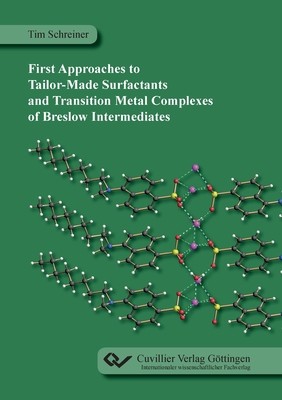
- We will send in 10–14 business days.
- Author: Tim Schreiner
- Publisher: Cuvillier
- ISBN-10: 3736971060
- ISBN-13: 9783736971066
- Format: 14.8 x 21 x 1 cm, softcover
- Language: English
- SAVE -10% with code: EXTRA
First Approaches to Tailor-Made Surfactants and Transition Metal Complexes of Breslow Intermediates (e-book) (used book) | bookbook.eu
Reviews
Description
Microemulsions are thermodynamically stable, macroscopically isotropic, nanostructured mixtures of at least three components: a polar, a non-polar and an amphiphilic; in general water, oil and surfactant. The surfactant, if optimally selected, generates an ultra-low interfacial tension and a large internal interface. Both properties are of central relevance in this thesis. In the first part, the new fluorescent surfactant class NaCX, YANS was synthesized, comprehensively characterized and first application-relevant studies in the field of cell labeling were carried out. The efficiency - namely the reduction of the interfacial tension - of this new surfactant class was demonstrated at the phase behaviour of non-ionic microemulsions in comparison with common ionic surfactants. As companion product, the highly efficient surfactant class NaCX, YABS was developed, which shows great potential for the independent formation of microemulsions without further co-surfactant. Since microemulsions can completely solubilize hydrophilic and lipophilic components, these systems are outstandingly suitable as reaction medium in organic synthesis across the internal interface. This was closer investigated in decomposition experiments of glucose by an N-heterocyclic carbene (NHC). Moreover, extensive complexation reactions of aldehyde adducts of NHCs (Breslow intermediates) with transition metal compounds provided initial insights into their coordination behaviour. In particular, the high reactivity of cobalt towards Breslow intermediates has been highlighte
EXTRA 10 % discount with code: EXTRA
The promotion ends in 20d.11:31:36
The discount code is valid when purchasing from 10 €. Discounts do not stack.
- Author: Tim Schreiner
- Publisher: Cuvillier
- ISBN-10: 3736971060
- ISBN-13: 9783736971066
- Format: 14.8 x 21 x 1 cm, softcover
- Language: English English
Microemulsions are thermodynamically stable, macroscopically isotropic, nanostructured mixtures of at least three components: a polar, a non-polar and an amphiphilic; in general water, oil and surfactant. The surfactant, if optimally selected, generates an ultra-low interfacial tension and a large internal interface. Both properties are of central relevance in this thesis. In the first part, the new fluorescent surfactant class NaCX, YANS was synthesized, comprehensively characterized and first application-relevant studies in the field of cell labeling were carried out. The efficiency - namely the reduction of the interfacial tension - of this new surfactant class was demonstrated at the phase behaviour of non-ionic microemulsions in comparison with common ionic surfactants. As companion product, the highly efficient surfactant class NaCX, YABS was developed, which shows great potential for the independent formation of microemulsions without further co-surfactant. Since microemulsions can completely solubilize hydrophilic and lipophilic components, these systems are outstandingly suitable as reaction medium in organic synthesis across the internal interface. This was closer investigated in decomposition experiments of glucose by an N-heterocyclic carbene (NHC). Moreover, extensive complexation reactions of aldehyde adducts of NHCs (Breslow intermediates) with transition metal compounds provided initial insights into their coordination behaviour. In particular, the high reactivity of cobalt towards Breslow intermediates has been highlighte


Reviews